On the Govi-Altai Mountains of Mongolia, the golden eagle is known as the “King of Heaven.”
Birds of prey are classified into three families, including all species belonging to the Falconiformes, Strigiformes, and Accipitriformes, among which the golden eagle is the most proficient predator in the Accipitriformes family, and it is at the top of the food chain.
Golden eagles, like most other carnivorous birds, do not easily change partners and remain bonded with their mate until death. As the cold winter passes and the warm spring arrives, blooming flowers and abundant food signal the beginning of the mating season, prompting golden eagle pairs to start mating and laying eggs.
Golden eagles are highly intelligent and possess strong adaptability. To protect their young from attacks by crows and snakes, golden eagle pairs will change their nests every two years.
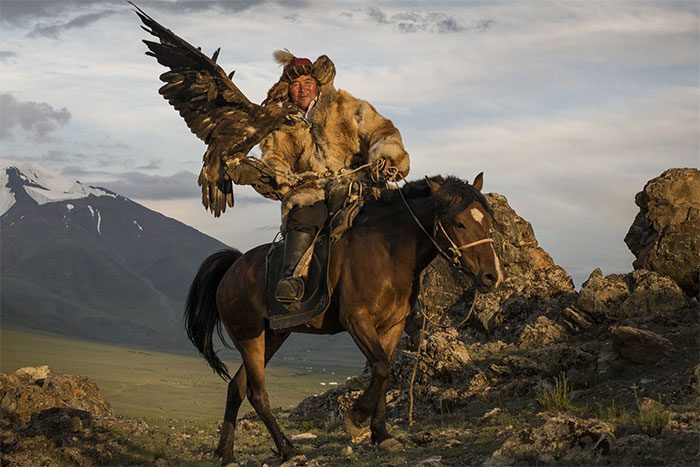
In Mongolia, it is often said: “A man must have three things: a fast horse, a loyal dog, and an eagle.” The sight of golden eagles soaring over the vast steppes has become a defining beauty of Mongolia. However, these are not merely wild eagles but also those that have been thoroughly trained.
Golden eagles build their nests on conifer trees taller than 30 meters, and sometimes they will nest on cliffs over 100 meters high, using pine needles, grass, and feathers to create warm and comfortable nests.
A female golden eagle can lay about 1 to 3 eggs at a time. However, to allocate resources and food efficiently, the female will lay eggs in a staggered manner, with a few days between each egg.
The eggs of golden eagles resemble those of other large carnivorous birds, being oval in shape, about 80 mm long, with natural olive-brown spots that camouflage them in the nest from afar. The egg’s coloration provides natural protective camouflage, making it difficult for other animals to distinguish between the eggs and the nest’s background color.
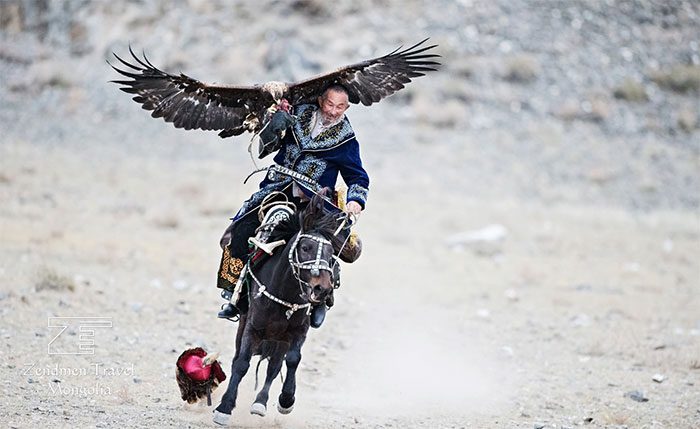
Currently, the profession of eagle training in Mongolia survives only in the mountainous regions inhabited by the Kazakh people in the far west, surrounded by the Altai Mountains – one of the most remote places on Earth. The Kazakh people have lived here for a long time, residing in large yurts, herding cattle and sheep, while maintaining the cultural traditions passed down from their ancestors.
After the female golden eagle lays her eggs, she begins to incubate them, while the male assumes the role of forager and protector of the family. It takes over a month for the incubated eggs to hatch, and during this time, both parents will hunt together as the chicks face their first challenges in nature.
The newly hatched golden eagle chicks are covered in soft down and are fully dependent on their parents for care. It takes a long time for them to learn hunting and survival skills, and during this period, they are highly vulnerable to accidents such as attacks from crows, snakes, and other predators, as well as falling from the nest for various reasons.
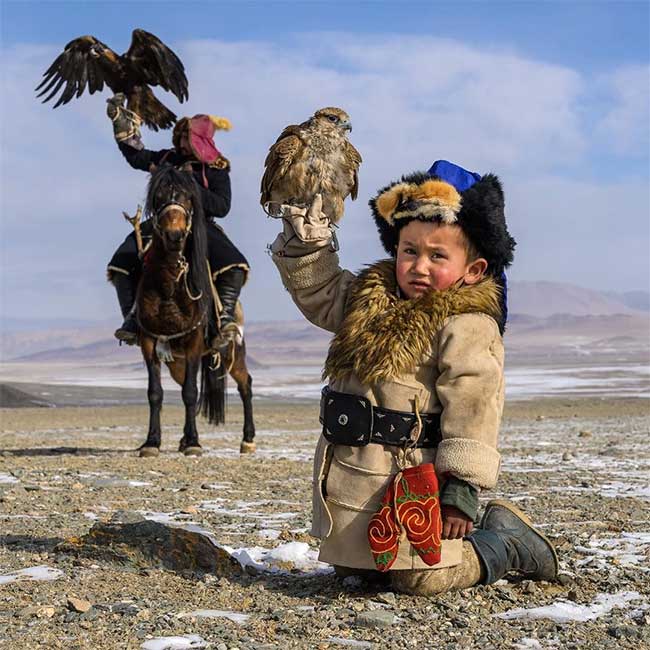
The golden eagle is a powerful bird frequently found in Central Asia. When fully grown, it weighs about 6.5 kg, has a body length ranging from 66 to 102 cm, and a wingspan over 2 meters. Golden eagles can swoop down to catch large prey like wolves at speeds of up to 200 km/h. Hunters must wait for the mother eagle to leave the nest in search of food to approach the eaglets. They then carefully catch these chicks to raise and train them.
Limited resources and food scarcity mean that not all chicks can thrive. When the golden eagle chicks hatch, the parents can provide enough food, but as they grow, their food needs increase, and the parents cannot find more food, leading to “fighting in the nest.”
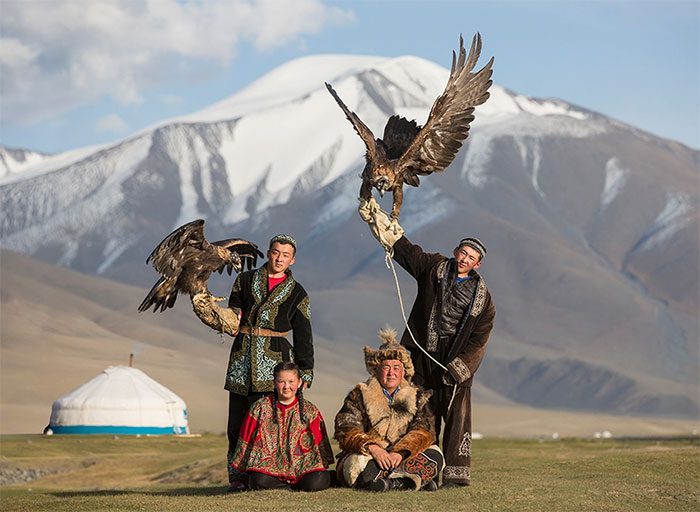
After being captured, a piece of leather is placed over its head so it cannot see anything, and then it is made to stand on a wooden perch swaying back and forth, preventing the eagle from gaining stability. After several nights, the eagle becomes exhausted and falls, at which point cold water is used to wake it up, and it is given water but not meat. After a few weeks of being hooded, the eagle begins to depend on its owner. Once the eagle is gradually tamed, it is finally fed. Feeding must also be done correctly; the trainer places a piece of meat on a leather patch on their shoulder to encourage the eagle to come eat.
Whenever they are unbearably hungry, the healthier chicks will harass the weaker ones, using their beaks to attack their “siblings.” The weaker chicks initially struggle to avoid attacks from others in the nest. Initially, this is merely an act of frustration due to food scarcity. However, over time, this aggression intensifies, and the weaker chicks may be pecked to death or eaten by their siblings, a natural survival rule for golden eagles.
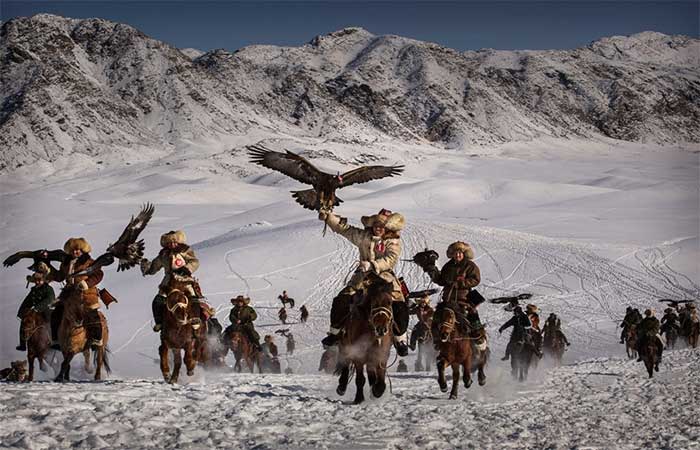
After a long period of hunger, the eagle becomes more desperate when it sees meat. The trainer increases the distance between the eagle and the meat each feeding time and never allows the eagle to feel full. They also stuff bloodied meat into rabbit or wolf dummies to teach the eagle to pounce on prey.
If the golden eagle chicks want to separate from their parents to live independently, the first skill they must learn is flying, the most basic hunting skill. Shortly after hatching, they will practice flying constantly, except when eating or resting. The first basic movement is to flap their wings rapidly, and before leaving the nest, the chicks must practice flapping for five minutes straight.
Then, they must practice standing on one leg and both legs, moving around in a nest over two meters in diameter. They continue this practice for over a month until feathers fully grow on their wings, at which point the young golden eagles will be ready for their first flight.
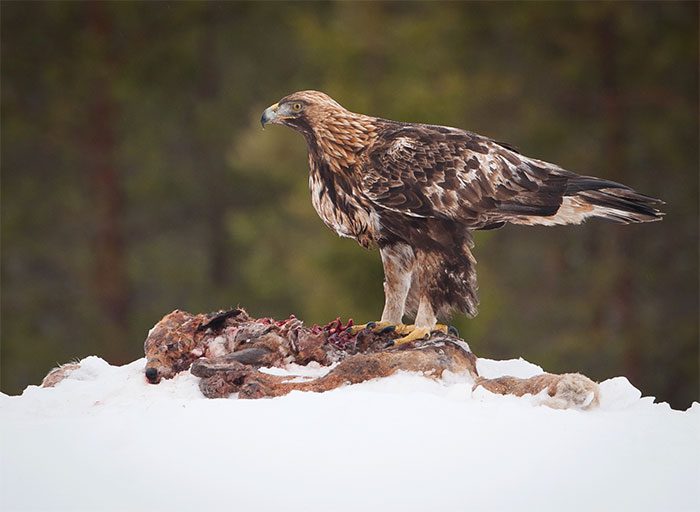
The talons on a golden eagle’s feet are curved and sharp. These sharp claws are their deadly weapons for attacking and capturing prey. This characteristic is why eagles are named after a Latin term “rapere”, meaning to grasp or seize. The vision of eagles is also formidable for their prey. On average, an eagle’s vision is eight times better than that of a human. They can detect small prey from miles away.
The young golden eagles have a strong instinct to fly, and they will approach the edge of the nest to relieve themselves to decrease body weight, then lean forward, push off the ground with their feet, spread their wings, and jump down for their first flight.
Of course, learning to fly is just the most basic skill for independent living; young golden eagles must learn hunting skills from their parents. The pair of golden eagle parents will bring wounded prey back to the nest and teach the young eagles how to hunt on their own. After more than 30 days of this training, the young golden eagles will gradually master flying and hunting skills, starting their independent lives in the wild.
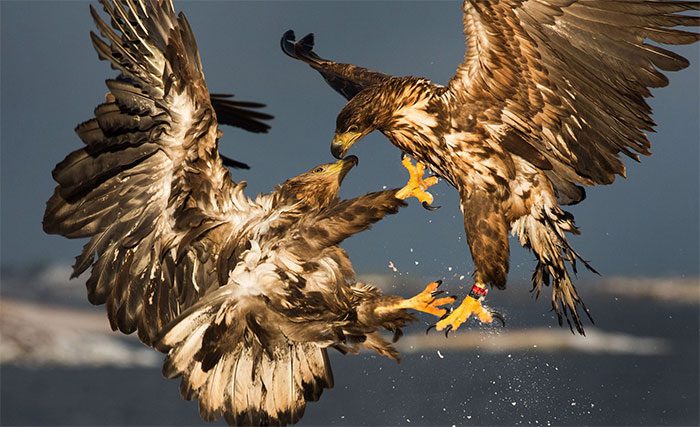
The diving speed of a golden eagle can reach 245 km/h, allowing it to strike and crush the bones of its prey mid-air.
The golden eagle has exceptional eyesight and can spot prey on the ground while soaring high in the sky. There are nearly 70 types of food suitable for golden eagles, including various birds and large to medium-sized mammals such as foxes, goats, swans, geese, and even wolves, which all serve as food for the golden eagle.
Some larger golden eagles have wingspans of up to 2.2 meters and are renowned for their superb flying skills, capable of changing flight posture freely and gliding in the air. By altering the angle of their wings, they can adjust their flight path to attack prey from any direction.




















































